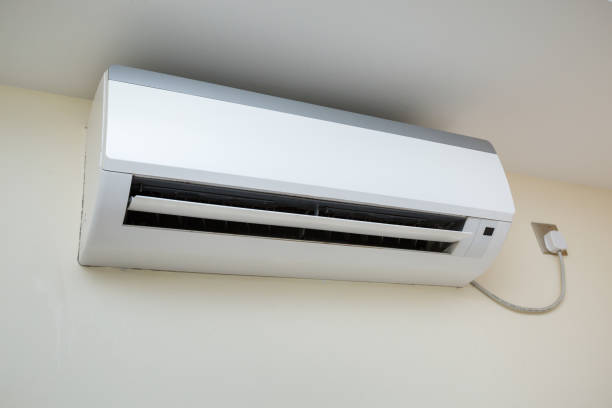Split system HVAC units might often be overshadowed by traditional central air systems and the emerging smart climate control technologies. Yet, they carve their niche with unmatched flexibility and efficiency. This unique character sets them apart in the vast world of HVAC solutions, offering a distinct experience that distinguishes split system HVAC as a category in its own right.
Key types of split system HVAC include Mini-split systems, Multi-split systems, and Ductless systems, each known for their specific benefits. Single-zone mini-split systems also stand out, offering targeted but comprehensive climate control for individual rooms. Going a bit deeper, each type of split system HVAC presents its own set of advantages, installation considerations, energy efficiency levels, and recommendations for maintenance.
The following sections will explore these aspects in detail, providing a richer understanding of what makes split-system HVAC a preferred choice for both residential and commercial spaces worldwide.
What is a split system HVAC?

A split system HVAC is a cutting-edge approach to heating and cooling, specifically engineered to enhance comfort in homes and businesses alike. It’s distinguished by its two-component structure: an outdoor unit, which includes the compressor and condenser, and an indoor unit, featuring the air handler and evaporator. This separation not only boosts the system’s efficiency but also allows for flexible installation options, making it an ideal choice for a variety of building layouts and sizes.
The split system shines in its ability to be customized, offering a tailored climate control solution that meets the unique needs of each space it serves.
Why choose a split system HVAC?
Opting for a split system HVAC brings a multitude of benefits, positioning it as a leading choice for superior climate management. One of its most compelling advantages is its energy efficiency, which not only leads to lower utility bills but also contributes to a greener planet. The space-saving design of split systems allows them to easily adapt to different home and office layouts, eliminating the need for invasive ductwork.
This makes them an excellent option for both modern constructions and historical buildings undergoing renovations. Moreover, split systems operate much more quietly than traditional HVAC units, ensuring a peaceful indoor environment. Collectively, these benefits underscore why a split system HVAC is an optimal solution for those prioritizing efficiency, convenience, and comfort in their climate control choices.
Energy Efficiency Leads to Lower Utility Bills
Energy efficiency is a hallmark of split system HVAC units, significantly reducing the amount of energy required to maintain comfortable temperatures. This efficiency not only results in lower utility bills but also lessens the environmental impact, making split systems a smart choice for eco-conscious consumers.
Space-Saving Design Fits Various Home Layouts
The space-saving design of split system HVACs allows for seamless integration into any home layout, from compact apartments to expansive houses. Their minimal footprint and flexibility in installation locations (wall, ceiling, or floor-mounted) mean that these systems can be adapted to suit the specific needs and constraints of any property, without the need for bulky ductwork.
Quieter Operation Compared to Traditional Systems
Split system HVAC units are celebrated for their quieter operation, a stark contrast to the often loud and disruptive traditional systems. This quietness is achieved by locating the noisier components, such as the compressor and condenser, outside the home. The result is a more peaceful and comfortable indoor environment, free from the distraction of constant mechanical noise.
How does a split system HVAC work?
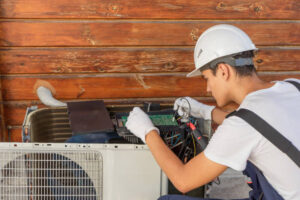
At its essence, a split system HVAC functions through a strategic division of roles between an outdoor unit and an indoor unit. The outdoor unit, equipped with the compressor and condenser, is tasked with expelling heat from the space. Meanwhile, the indoor unit, which includes the air handler and evaporator, circulates cooled or warmed air inside the building.
This dual-component approach enhances the system’s efficiency, enabling precise temperature control with reduced energy consumption. Together, these units collaborate seamlessly, ensuring a comfortable indoor environment tailored to your preferences.
Outdoor Unit Contains the Compressor and Condenser
The outdoor unit is a fundamental component of a split system HVAC, equipped with the compressor and condenser. These elements are pivotal in the heat expulsion process, efficiently removing heat from the indoor air and releasing it outside. This unit’s strategic placement outdoors enhances the overall efficiency of the cooling cycle, ensuring a swift and effective reduction in indoor temperatures.
Indoor Unit Includes the Air Handler and Evaporator
At the heart of the split system, the HVAC’s indoor unit is the air handler and evaporator. This combination is key to the system’s ability to provide a cooler, more comfortable indoor climate. The evaporator coil plays a critical role in absorbing heat from the indoor air, while the air handler circulates the newly cooled air back into the room.
Together, these components work seamlessly to maintain the desired temperature and comfort level within your space.
Related Reading: How Does HVAC Work: Unveiling the Secrets of Comfort and Air Quality
Types of Split System HVAC
Split system HVAC units are tailored to meet a wide range of heating and cooling needs, categorized primarily into Mini-split systems and Multi-split systems. Mini-split systems are ideal for single-room applications, providing precise temperature control in a compact, ductless format. This makes them a perfect choice for adding climate control to spaces where extending existing ductwork is impractical or too costly.
On the other hand, Multi-split systems extend the concept to multiple rooms or zones within a building, allowing for individual temperature settings in each area. This flexibility makes multi-splits a popular option for residential and commercial spaces alike, where different rooms may have varying heating and cooling needs. Each type is engineered for efficiency, adaptability, and performance, ensuring a suitable split system HVAC option is available for any setting.
Mini-Split Systems for Single Rooms
Mini-split systems excel in providing precise climate control for single rooms. These units are a perfect match for spaces where adding or extending ductwork is not feasible, such as home additions, small offices, or individual rooms in larger houses. Their ductless nature simplifies installation, making them an efficient and flexible option for targeted heating and cooling.
Mini-splits are celebrated for their compact design and ability to deliver comfort exactly where it’s needed, without the complexities and costs associated with traditional HVAC systems.
Multi-Split Systems for Multiple Rooms
Multi-split systems bring the adaptability of split system HVAC to multiple rooms or zones within a property. By allowing individual temperature control in each designated area, multi-splits cater to the diverse comfort needs of occupants in different spaces. This capability is especially advantageous in larger residential or commercial environments, where the heating and cooling requirements can significantly vary from one room to another.
Multi-splits ensure that each zone is maintained at an optimal temperature for comfort and energy efficiency, making them a smart solution for comprehensive climate management across multiple areas.
Related Reading: Central Air Conditioner Types: Find the Perfect Fit for Your Home or Business
Installation Considerations for Split System HVAC
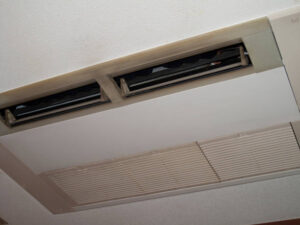
When embarking on the installation of a split system HVAC, it’s crucial to navigate a few essential factors to secure its best performance. Professional installation stands out as a non-negotiable, ensuring the system’s components are correctly positioned and connected for optimal operation. The space allocated for the outdoor and indoor units requires careful consideration, as strategic placement can significantly impact efficiency and functionality.
Furthermore, the electrical requirements of the system demand attention, with each model having specific needs that must be adequately addressed to ensure safety and reliability. Prioritizing these considerations during the installation process lays the groundwork for a smoothly running, efficient HVAC system tailored to your space’s unique requirements.
Professional Installation Ensures Proper Setup
Professional installation is crucial for the correct setup of a split system HVAC. Expert technicians bring the necessary skills to install the system effectively, ensuring each component is correctly connected and operational. This expertise not only optimizes the system’s performance but also minimizes the risk of future operational issues, securing a reliable climate control solution.
Necessary Space for Outdoor and Indoor Units
Allocating the necessary space for both the outdoor and indoor units is a vital step in the installation process of a split system HVAC. The outdoor unit requires a space that supports adequate airflow and efficient heat dissipation, while the indoor unit’s placement should promote even air distribution within the space. Strategic positioning of these units is essential for maximizing the system’s efficiency and the comfort it provides.
Electrical Requirements Must Be Met
Adhering to the electrical requirements is fundamental for the safe operation of a split system HVAC. Each system demands specific power inputs, which must align with the building’s electrical infrastructure. Professional installers are adept at evaluating these needs and ensuring that the electrical setup is properly configured to support the HVAC system, guaranteeing safety and optimal functionality.
Maintenance of Split System HVAC
Keeping a split system HVAC in top condition is key to its performance and longevity. Regular cleaning of filters and coils is crucial, as it prevents the buildup of dust and debris that can hinder the system’s efficiency. In addition to cleaning, professional check-ups are vital for early detection and resolution of any potential issues.
These preventative measures ensure the system operates at its best, prolonging its lifespan while maintaining high levels of heating and cooling effectiveness. Embracing a consistent maintenance routine is not only beneficial for the system’s health but also enhances the quality of indoor air, making it a healthier environment for everyone.
Regular Cleaning of Filters and Coils
Regular cleaning of filters and coils is a cornerstone of split system HVAC maintenance. Keeping these components clean ensures unobstructed airflow and prevents the system from working harder than necessary, thereby conserving energy and extending the unit’s lifespan. Regularly removing dust and debris from filters and coils not only boosts the system’s efficiency but also maintains a high standard of indoor air quality, contributing to a healthier living environment.
Professional Check-Ups to Prevent Major Issues
Professional check-ups play a pivotal role in the preventative maintenance strategy for split system HVAC units. These thorough inspections, carried out by certified technicians, are designed to detect and rectify minor issues before they develop into costly repairs. Regular professional assessments can identify wear and tear, system imbalances, and other concerns early on, ensuring the HVAC system operates smoothly and reliably throughout its service life.
This proactive approach minimizes the risk of unexpected breakdowns and maximizes the performance of the climate control system.
Cost of Split System HVAC
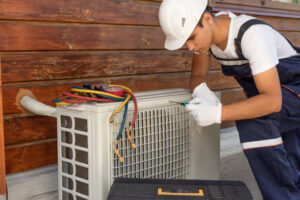
The cost of a split system HVAC is a multifaceted consideration that goes beyond the initial price tag. It encompasses the initial installation, which might be higher than traditional systems due to the specialized equipment and labor involved. However, the energy efficiency of split systems translates into lower utility bills, presenting an opportunity for substantial savings in the long run.
Additionally, ongoing maintenance costs are an important factor, as regular servicing is crucial for maintaining efficiency and prolonging the system’s lifespan. When evaluating the cost of a split system HVAC, it’s essential to consider these aspects to gain a comprehensive understanding of both immediate and future financial implications, as well as the potential for significant energy savings over time.
Initial Installation Can Be Higher Than Traditional Systems
The initial installation cost of a split system HVAC typically surpasses that of traditional HVAC systems. This difference stems from the need for specialized equipment and the intricacy involved in installing both indoor and outdoor units. Despite this higher upfront cost, the long-term benefits, including energy efficiency and installation flexibility, often justify the initial investment, providing value over the lifespan of the system.
Ongoing Maintenance Costs Vary by Usage
Ongoing maintenance costs for a split system HVAC are influenced by factors such as usage intensity and operational environment. Consistent maintenance, including regular cleaning and professional check-ups, is vital for ensuring the system remains efficient. While there is a cost associated with maintaining the system, this expenditure is crucial for maximizing its efficiency and longevity, ultimately contributing to cost savings over time.
Potential Savings from Energy Efficiency
The potential savings realized through the energy efficiency of split system HVAC units can be substantial. Designed to operate more efficiently than traditional systems, split systems can significantly reduce energy consumption, leading to noticeable reductions in utility bills. Although the initial installation cost may be higher, the energy savings achieved can help offset this expense, making split systems a financially viable option in the long term.
Related Reading: How Much is a New HVAC System?
Choosing the Right Split System HVAC
Choosing the right split system HVAC requires a strategic approach that considers several key factors. Firstly, it’s crucial to assess the size of your home and understand the cooling and heating needs of each room to identify the most effective system capacity. Comparing different brands and models is also essential, as it allows you to weigh the benefits of various features and technologies against your specific requirements.
Additionally, the climate and seasonal use in your area should play a significant role in your decision-making process, ensuring that the system you select is capable of delivering efficient performance under the local weather conditions. By carefully evaluating these aspects, you can choose a split system HVAC that offers the perfect balance of functionality, energy efficiency, and cost-effectiveness for your living or working environment.
Assessing Home Size and Cooling Needs
Assessing the size of your home and its specific cooling needs is foundational in choosing the right split system HVAC. It’s important to select a system with the capacity that precisely matches the square footage and unique characteristics of your space, ensuring efficient temperature control. Accurate assessment prevents the inefficiency of an oversized system or the inadequacy of an undersized one, optimizing both comfort and energy consumption.
Comparing Brands and Models for Features
Comparing brands and models for their features is a critical step in finding the split system HVAC that best suits your requirements. Each option comes with a distinct set of features, from energy efficiency ratings to smart technology integrations, which can significantly impact your home’s climate control experience. Careful comparison allows you to understand the benefits and limitations of each model, guiding you to a choice that meets your expectations for comfort, convenience, and energy savings.
Considering Climate and Seasonal Use
Considering the climate of your location and the seasonal use of the HVAC system is crucial for selecting a system that performs optimally year-round. The effectiveness of a split system HVAC in extreme weather conditions and its adaptability to seasonal changes can greatly affect your indoor comfort and energy efficiency. Systems tailored to withstand the specific climatic challenges of your region will provide more reliable performance and better adapt to your seasonal heating and cooling needs.
Split System HVAC: Troubleshooting Common Issues
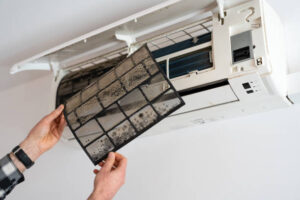
Identifying and addressing common issues in a split system HVAC is essential for ensuring its efficiency and longevity. Key indicators of problems include inconsistent cooling or heating, which may signal system imbalances; strange noises or odors, pointing to potential mechanical failures or blockages; and an unexpected increase in energy bills, which could suggest the system is operating inefficiently. Timely troubleshooting of these signs can help avert more significant issues, maintaining the system’s performance and contributing to a consistently comfortable indoor climate.
Recognizing and acting upon these early warning signs is crucial for the health and efficiency of your split system HVAC.
Inconsistent Cooling or Heating
Inconsistent cooling or heating often signals underlying problems within a split system HVAC, such as refrigerant leaks, clogged air filters, or issues with the thermostat. These conditions can lead to discomfort and uneven temperatures throughout your home or office, highlighting the need for diagnostic checks and timely repairs.
Strange Noises or Odors
Encountering strange noises or odors from your split system HVAC is a clear sign of potential trouble. Odd sounds like rattling or hissing may indicate loose components or air leaks, while unusual odors could point to mold, mildew, or even electrical issues. Addressing these symptoms promptly can prevent further damage and maintain air quality.
Increased Energy Bills Indicating Inefficiency
An increase in energy bills, particularly when usage patterns haven’t changed, is a strong indicator of inefficiency in your split system HVAC. Factors contributing to this inefficiency could include leaking ductwork, insufficient insulation, or the system working overtime due to maintenance neglect. Identifying and correcting these issues can help regain energy efficiency, reducing monthly expenses.
In Summary
At Callidus Air, we specialize in providing top-tier split system HVAC solutions tailored to meet the unique needs of both residential and commercial properties. Our expert team is dedicated to delivering efficient, reliable service, ensuring that each installation maximizes comfort and energy savings. Trust Callidus Air to enhance your space with the advanced technology and customizable features of split system HVAC.
Experience the future of climate control with Callidus Air—contact us today to explore our innovative split system HVAC options!

